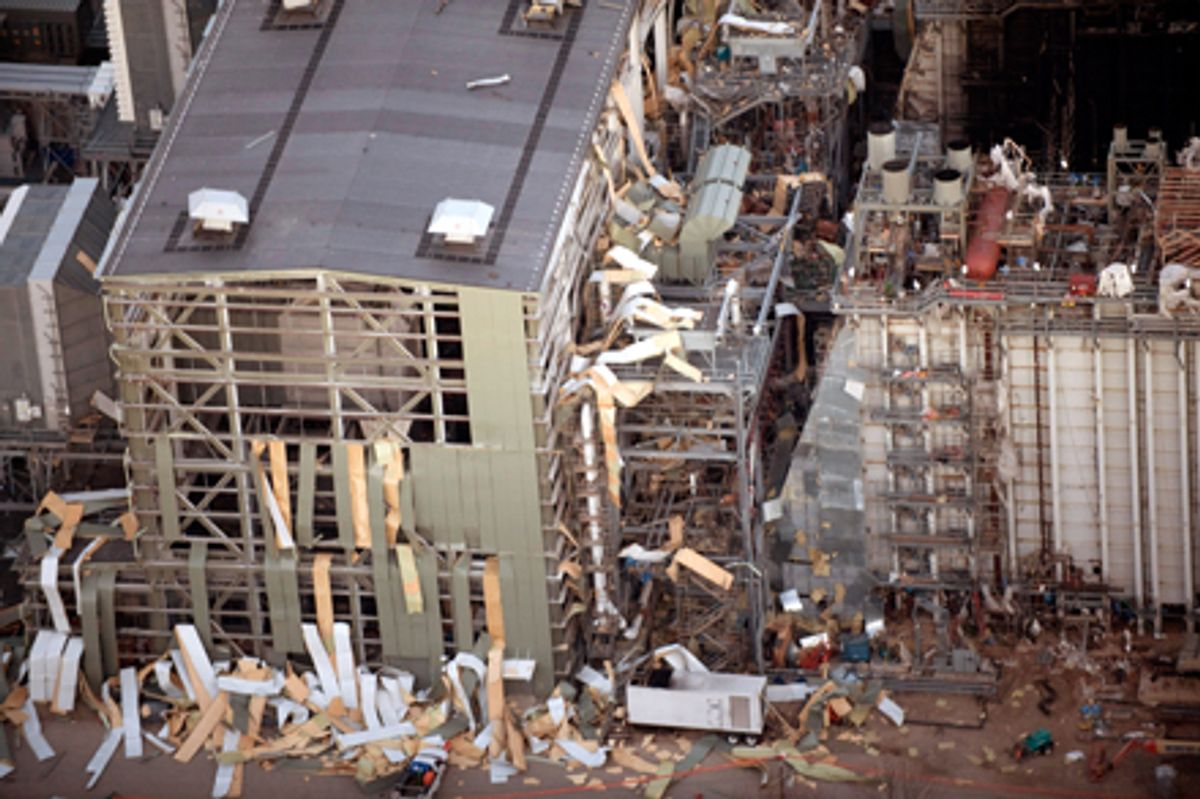Who was it that said, “We learn from history that we learn nothing from history”? Proof of their wisdom came on 7 February, three days after the U.S. Chemical Safety Board held a public hearing to present its initial findings regarding the cause of the natural gas explosion that rocked a ConAgra Food plant in Garner, N.C., the previous June. (The ConAgra plant is the world’s sole producer of Slim Jim, the beef jerky snack with the dimensions of two or three cigarettes put together end to end.)
Just after 11 a.m., a huge explosion and fire were set off at the Kleen Power Plant in Middletown, Conn., when workers there attempted to purge a natural gas pipeline by venting the inert gases used to test whether there are any leaks in the system. Where did they vent the gas? Indoors. The last stage of the test involves flushing out the inert gases with natural gas. Workers apparently relied on their senses of smell to tell them when the inert gas had been fully expelled. The thinking was that the same additive that allows you to smell the gas emitted from your stovetop when there is no flame to consume it would be a good enough indicator that the purging was complete. But it’s now apparent that well before the smell of gas told the workers to shut off the gas or shut the release valve, it had built up to an explosive concentration and was set off by an as yet undetermined ignition source.
The five people who were killed and the 12 others who were injured by the blast and subsequent blaze at the Kleen Power Plant needn’t have suffered those fates. At the Chemical Safety Board hearing in Raleigh, N.C., a few days earlier, experts highlighted several lapses in judgement that together set the stage for the ConAgra explosion that killed three people, injured 71 others, and caused a worldwide Slim Jim shortage. They were basically the same lapses that would doom the workers at the Connecticut power plant.
First of all, the experts noted, natural gas should be vented outdoors, where there is less of a possibility that it might collect and explode. Why it took an august panel of the keenest minds to figure that one out remains a mystery.
The board also recommended that fire safety personnel be present whenever flammable gas lines are being vented and that everyone participating in the procedure is trained in how to do the job properly. Having people on site who know what they’re doing? What a novel idea!
Another important suggestion was that widely available electronic sensors similar to the carbon monoxide detectors in residences be used during this type of operation. What’s known but often overlooked is that relying on the chemical added to gas to make us able to sniff it out is a deadly gamble. Our olfactory sense is set up to respond to changes. After you’ve been in a room with a scent for a while, your brain basically relegates it to the background, a phenomenon known as odor fade. Bottom line: lives were lost and millions of dollars of damage was done for want of a US $40 gadget that anyone can buy on Amazon.com.
Though blowing a hole through the side of a billion-dollar electric power plant is nothing to sneeze at, the Middletown explosion didn’t have as great an immediate impact on commerce as the Great Slim Jim Famine of 2009. The Kleen Energy plant, whose construction was said to be 95 percent complete, was being built as part of a decade-long effort to improve southwest Connecticut’s access to electric power. That region—where peak energy demand grew 27 percent between 1999 and 2004—had few local generating facilities and was served by an overmatched patchwork of 115 kilovolt transmission lines. Those lines were the area’s only links to the ISO-New England power pool that had 345-kilovolt cables covering the rest of the state, plus Maine, Massachusetts, New Hampshire, Rhode Island, and Vermont.
When the power plant was approved by the Connecticut Siting Council, it was envisioned as an additional power source that would feed the two 345 kV lines stretching deep into the state’s southwest corner that were also on the drawing board. It would, its backers argued, prevent repeats of the multiple summer days when municipalities such as New Haven, Norwalk, and Stamford suffered brownouts (wherein a reduction of voltage dims the lights) and rolling blackouts (where power is interrupted for a brief period to keep the system from completely crashing).
But a funny thing happened on the way to the Kleen Energy plant’s completion. The global economic downturn that began in 2008 upset power marketers’ projections about demand growth. With businesses going under, others scaling back production, and fewer people moving to the area as the boom went bust, peak demand moved back from the brink. The generating facility was suddenly no longer sorely needed as of yesterday. It could wait well beyond tomorrow.
“Any delay in bringing the Kleen Power facility online will have absolutely no effect on our ability to supply electric power to our customers, nor will it affect the price they pay for electricity,” says Mitch Gross, a spokesman for Connecticut Light & Power, southwestern Connecticut’s main utility. “We have a capacity contract [with Kleen Energy's operators] ensuring that the power would be there if needed, but we’ve already purchased all the power we’ll need for 2010 and most of what we’ll need to meet demand in 2011.”
ISO-New England notes that surplus capacity is available—and not just in Connecticut. “Generating facilities across the country—especially coal-fired ones in the Midwest—are being idled because of insufficient demand,” says Erin O’Brien, a spokesperson for the power pool. O’Brien notes that the demand growth in southwestern Connecticut prior to 2008 would have made the Kleen Power plant’s use as a base load facility a foregone conclusion. Now? “It will run regularly or at intervals, depending on market and system reliability needs,” says O’Brien.
All the more reason why the loss of life on that Sunday morning—where the likely proximate cause was cut corners—was so tragic.
Photo: Douglas Healey/Getty Images
Willie Jones is an associate editor at IEEE Spectrum. In addition to editing and planning daily coverage, he manages several of Spectrum's newsletters and contributes regularly to the monthly Big Picture section that appears in the print edition.



